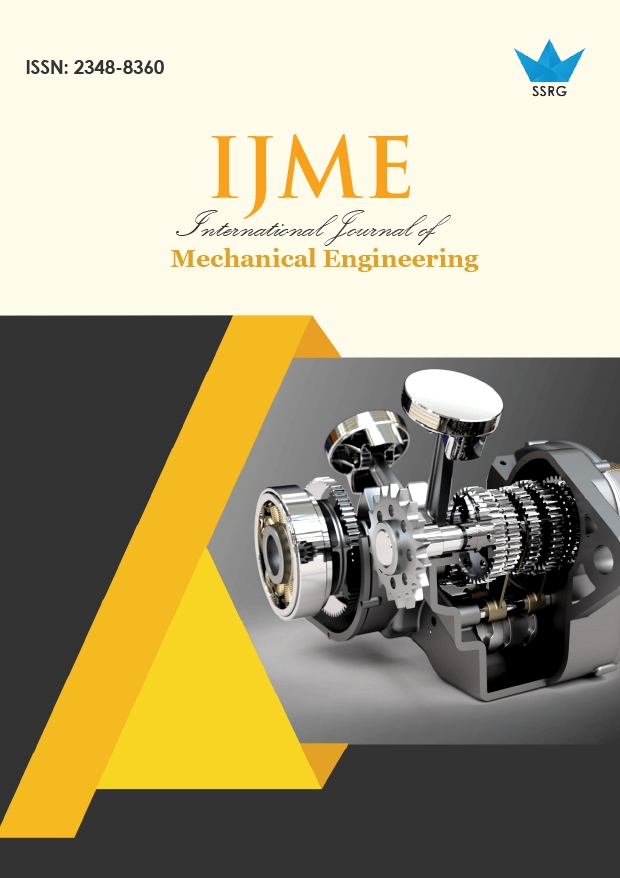Performance and CO/CO2 Emission of Three Different Biomass Stoves Fed With Coconut Shell Briquettes

| International Journal of Mechanical Engineering |
| © 2019 by SSRG - IJME Journal |
| Volume 6 Issue 10 |
| Year of Publication : 2019 |
| Authors : M.D. Saputra, A. A. P. Susastriawan, I.M. Suardjaja, B.W. Sidharta |
How to Cite?
M.D. Saputra, A. A. P. Susastriawan, I.M. Suardjaja, B.W. Sidharta, "Performance and CO/CO2 Emission of Three Different Biomass Stoves Fed With Coconut Shell Briquettes," SSRG International Journal of Mechanical Engineering, vol. 6, no. 10, pp. 8-11, 2019. Crossref, https://doi.org/10.14445/23488360/IJME-V6I10P102
Abstract:
The present work aims to investigate the performance of three different biomass stoves fed with coconut shell briquettes. The stoves' performance is evaluated in terms of fuel consumption rates, firepower, thermal efficiency, and pollutant emissions of C.O. and CO2 using the Chinese Water Boiling Test (WBT) method. The clay stove (stove B) has the best performance compared to the concrete stove (stove A) and the metallic stove (stove C). The thermal efficiency of the clay stove is the highest among the threes. The stove A, B, and C's thermal efficiencies are 14.77%, 17.33%, and 14.88%, respectively. On the other hand, the fuel consumption rate and CO/CO2 emission are the lowest in the clay stove. The fuel consumption rate of 0.54 kg/h and the CO/CO2 emission of 0.11 is observed in the clay stove.
Keywords:
biomass, briquettes, performance, stove, thermal.
References:
[1] Sedighi, M. and Salarian H. (2017). "A comprehensive review of technical aspects of biomass cookstoves," Renewable and Sustainable Energy Reviews (70) 656–665
[2] Parmigiani, S.P., Vitali, F., Lezzi, A.M., Vaccari, M. (2014). "Design and performance assessment of a rice husk fueled stove for household cooking in a typical sub-Saharan setting," Energy for Sustainable Development (23) 15–24
[3] Wang J., Lou, H.H., Yang F, Cheng F. (2016). "Development and performance evaluation of a clean-burning stove," Journal of Cleaner Production (134) 447-455
[4] Sornek K., Mariusz Filipowicz M., Rzepka K. (2016). "Study of clean combustion of wood in a stove-fireplace with accumulation," Journal of the Energy Institute xxx 1-11
[5] Singh B, Sethi V.P., Dhiman M, Sharma A. (2018). "Design, evaluation, and heat transfer analysis of novel forced draft paddy straw bale combustor using heat sink pipe networks for greenhouse heating," Energy Conversion and Management (173) 244–261
[6] Sutar K.B., Kohli S, Ravi M.R., Ray A. (2015). "Biomass cookstoves": A review of technical aspects, Renewable and Sustainable Energy Reviews (41) 1128–1166
[7] Kumar M, Kumar S, S.K. Tyagi S.K. (2013). "Design, development and technological advancement in the biomass cookstoves": A review, Renewable and Sustainable Energy Reviews (26) 265–285
[8] Jean Michel Sagouong*, Ghislain Tchuen "Mathematical Modelling of Traditional Stoves using the Thermal Network Approach," International Journal of Engineering Trends and Technology (IJETT), V58(1),1-9 April 2018. ISSN:2231-5381
[9] Berrueta V.M., Edwards R.D., Masera O.R. (2008). "Energy performance of wood-burning cookstoves in Michoacan," Mexico, Renewable Energy (33) 859–870
[10] Chen Y., Shen G., Su S., Du W., Huangfu Y., Liu G., Xing B., Smith K.R., Tao S. (2016). "Efficiencies and pollutant emissions from forced-draft biomass-pellet semi-gasifier stoves: Comparison of International and Chinese water boiling test protocols," Energy for Sustainable Development (32) 22–30
[11] Kirch T., Medwell P.R., Birzer C.H. (2016). "Natural draft and forced primary air combustion properties of a top-lit up-draft research furnace," Biomass and Bioenergy (91) 108-115
[12] Raman P, Murali J, Sakthivadivel D, Vigneswaran V.S. (2013). "Performance evaluation of three types of forced draft cookstoves using fuelwood and coconut shell," Biomass and Bioenergy (49) 333-340
[13] Suresh R., Singh V.K., Malik J.K., Datta A., Pal R.C. (2016). "Evaluation of the performance of improved biomass cooking stoves with different solid biomass fuel types," Biomass and Bioenergy (95) 27-34
[14] Susastriawan A.A.P., Badrawada, I.G., Budi D.P. (2019) "An effect of primary air draft and flow rate on thermal performance and CO/CO emission of the domestic stove fed with the briquette of coconut shell," Biomass Conversion and Biorefinery.
[15] Tryner J, Willson B.D., Marchese A.J. (2014). "The effects of fuel type and stove design on emissions and efficiency of natural-draft semi-gasifier biomass cookstoves," Energy for Sustainable Development (23) 99–109
[16] Trudel E, Hallett, W.L.H.., Berdusco D., Wiens E, O'Neil J.D., Busigin M.K. (2018). "Fuel particle shape effects in the packed bed combustion of wood," Combustion and Flame (198) 100–111
[17] Yuntenwi E.A.T., MacCarty N., Still D., Ertel J. (2008). "Laboratory study of the effects of moisture content on heat transfer and combustion efficiency of three biomass cookstoves," Energy for Sustainable Development, Vol. XII No.
[18] Meng X., Sun R., Zhou W., Liu X., Yan Y., Ren. (, 2018). "Effects of corn ratio with pine on biomass co-combustion characteristics in a fixed bed," Applied Thermal Engineering (142) 30–42
[19] Grimsby L.K., Borgenvik E.J. (2013). "Fuelling sawdust stoves with jatropha fruit coats," Sustainable Energy Technologies and Assessments (2) 12–18
[20] Chandral Pal Singh Inda, Ankit Goyal, Sunil Kumar Bhati, Dr. Jai Gopal Gupta, "A Experimental Study on Performance and Emission Characteristics of JATROPHA & DIESEL
blend" SSRG International Journal of Thermal Engineering 3.3 (2017): 6-11.
[21] Jetter J.J., Kariher P. (2009). "Solid-fuel household cookstoves": Characterization of performance and emissions, Biomass and Bioenergy (33) 294–305

 10.14445/23488360/IJME-V6I10P102
10.14445/23488360/IJME-V6I10P102